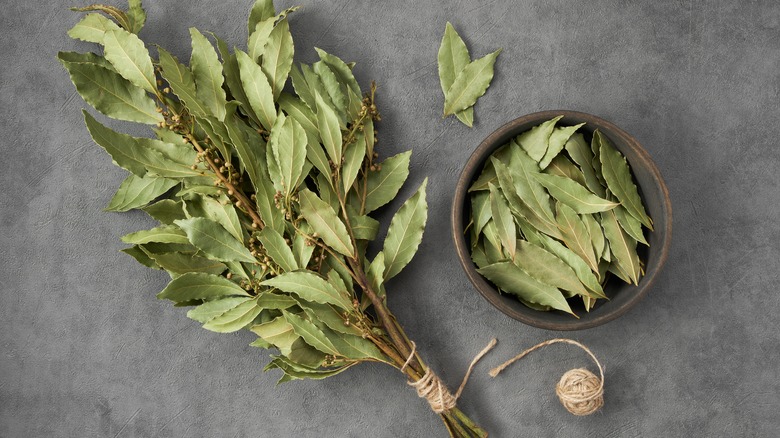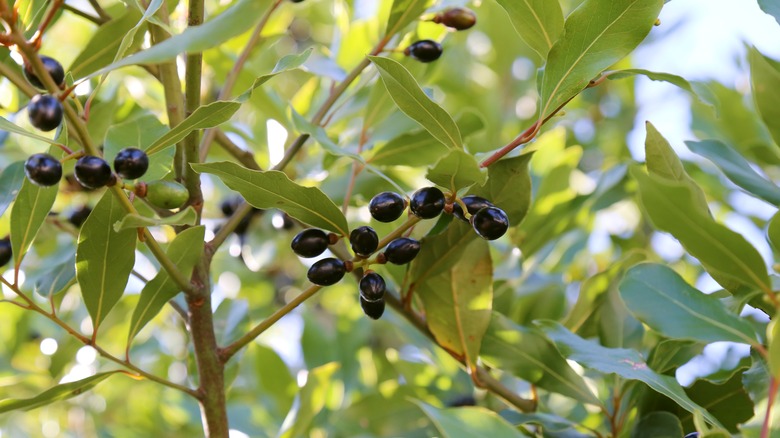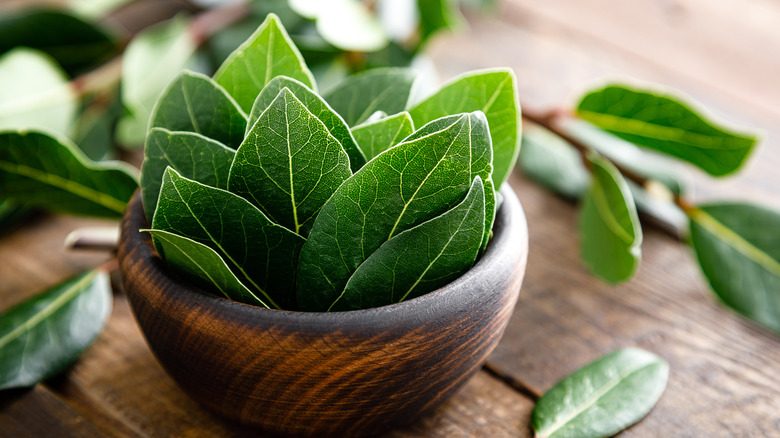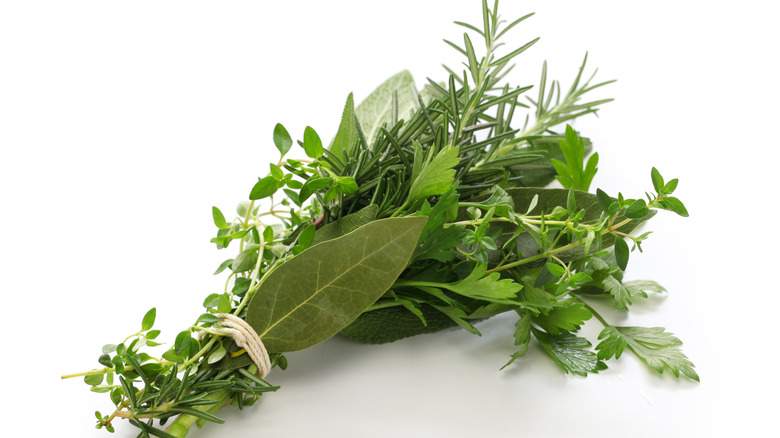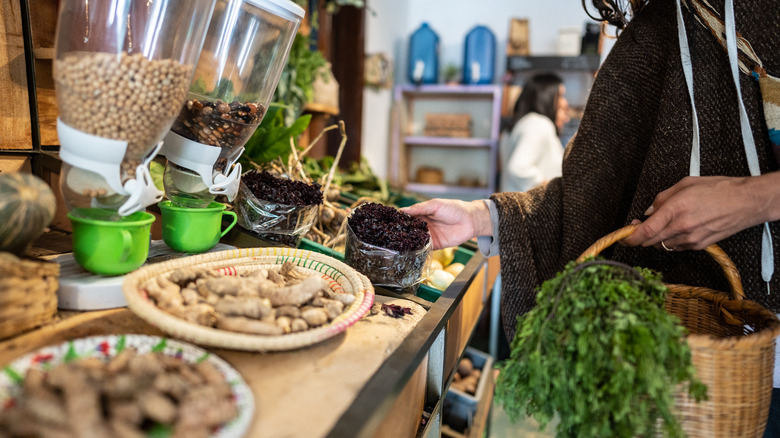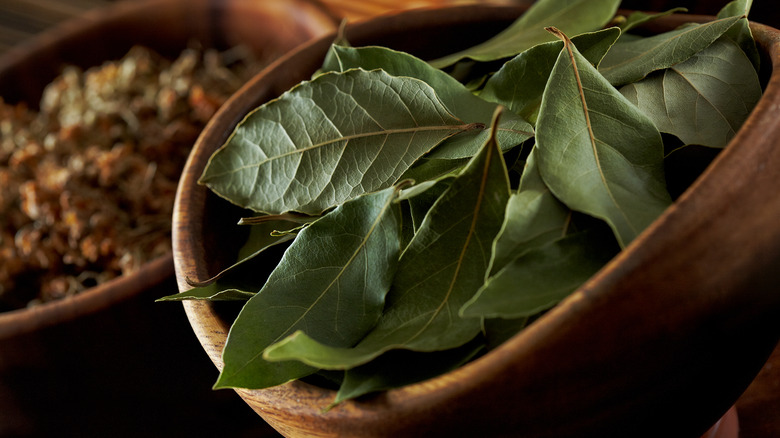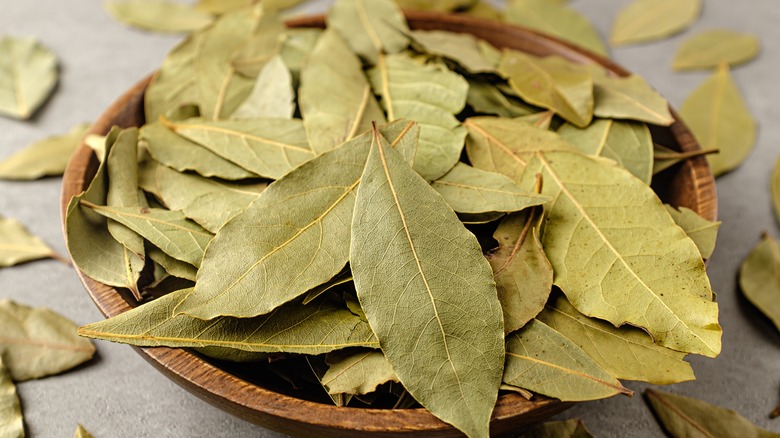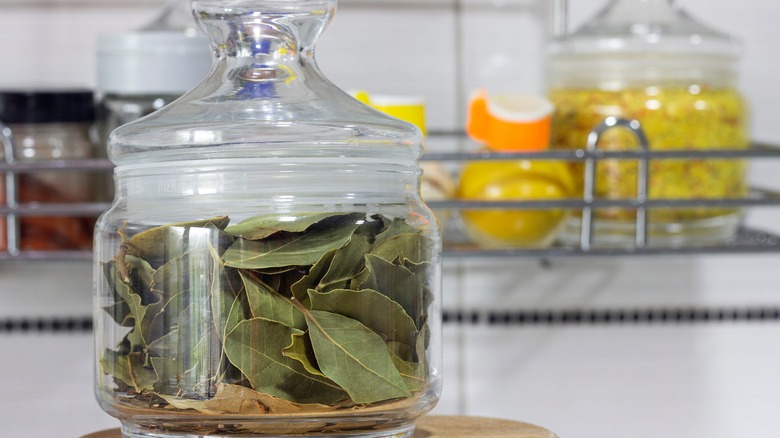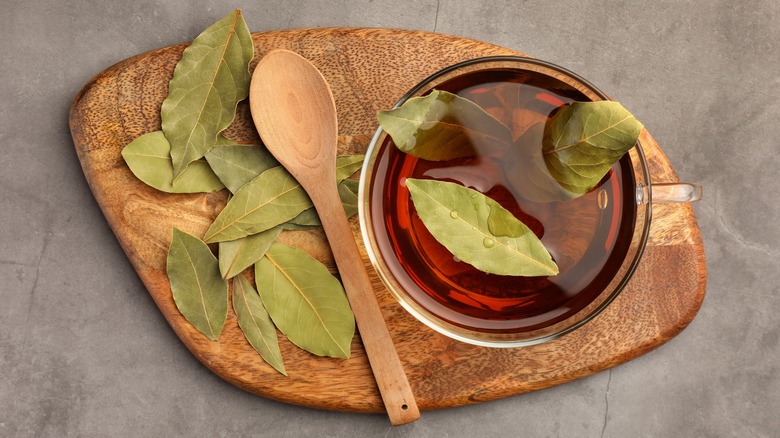A Guide To Bay Leaves And How To Use Them
We may receive a commission on purchases made from links.
Bay leaves, often underestimated and overlooked in the kitchen, hold more significance than meets the eye. Since ancient times, these leaves have been utilized for various purposes, including cooking, healing, and even warding off evil spirits. In cooking, bay leaves are typically used to add flavor and aroma to dishes, often steeped in soups, stews, and sauces. However, due to their understated supporting role in bringing out flavors in dishes, many modern home cooks question the importance of bay leaves, leading some to omit them from recipes altogether.
While bay leaves may not be as popular as other herbs like oregano, parsley, or basil, they are a common ingredient in many cuisines around the world. From Mexican to Indian cuisine, bay leaves are used to enhance the flavor and aroma of dishes, adding a layer of complexity that is sometimes overlooked.
Before you accidentally dismiss the significance of bay leaves, it's important to understand their true value and how to use them properly. When used correctly, bay leaves can enhance and bring out a delightful flavor in your dish, even though it can be subtle and not immediately noticeable. The next time you're simmering a pot of soup or stewing a hearty braise, do not skip the humble bay leaf — it may just be the secret ingredient that makes your dish uniquely flavorful and distinctive.
The history and mythology of bay leaves
Bay leaves hold a fascinating history rooted in ancient mythology and folklore. In ancient Greece, bay leaves were revered, because they were believed to enhance prophetic abilities; it was thought that consuming these leaves could grant individuals deeper insights into the future. Additionally, bay leaves were used as decorative elements, with Greeks believing that these leaves and branches could protect against natural calamities and ward off evil spirits.
The symbolism of bay leaves extended beyond prophetic and protective powers. In both ancient Greece and Rome, bay leaves were associated with victory and wisdom. Victorious athletes, scholars, and poets were often crowned with wreaths made of bay leaves as a symbol of their achievements. These laurel wreaths, or 'laurels,' became synonymous with honor and accomplishment.
Beyond their spiritual and cultural significance, bay leaves have also been valued for their practical use since ancient times. Throughout ancient Greece, Rome, and the Middle Ages, bay leaves were utilized for their aromatic qualities and medicinal applications. During these times, they were used to assist difficult labors, heal snake bites or bee stings, among other ailments.
Varieties of bay leaves
The bay laurel tree, scientifically known as Laurus nobilis, belongs to the Lauraceae family and is native to the Mediterranean region. It's an evergreen shrub or small tree that can grow up to 40 feet tall. The leaves are oval, glossy, and dark green, with a leathery texture, typically about three inches long. Apart from the Mediterranean bay tree, there are several varieties of bay laurel trees found around the world today, each with slightly different characteristics. Some of these varieties are totally different plant species to the Mediterranean bay leaf, but are still considered 'bay leaves' due to their similar aromatic properties and traditional culinary uses.
The California bay leaf (Umbellularia californica), also known as Oregon myrtle or pepperwood, is native to the western United States. It's similar in appearance to the Mediterranean bay leaf and can be used in cooking, usually with a stronger and more pungent taste than the Mediterranean bay laurel. The Indian bay leaf (Cinnamomum tamala), also known as tejpat, has a strong, floral scent, and slightly spicy flavor, making it more suitable for curries than as a substitute for the common bay leaf. On the other hand, Indonesian bay leaves (Syzygium polyanthum) are more subtle, slightly sour, and astringent, and work well in soups, curries, and stews. The Mexican bay leaf (Litsea glaucescens) also has a milder flavor, while the Turkish bay leaf (Laurus nobilis var. lauris) tastes similar to the Mediterranean bay leaf, but slightly sweeter and more complex.
Fresh vs dried bay leaves
Bay leaves are a versatile ingredient that can be used both fresh and dried. Fresh bay leaves have a more pronounced flavor and aroma, which can easily overpower other ingredients in a dish if overused or steeped for too long. They're best used in dishes with shorter cooking times or where a more intense bay leaf flavor is desired. On the other hand, dried bay leaves are more subtle and are ideal for adding depth to slow-cooked dishes. The drying process decreases the water content and preserves the flavors of the bay leaves, making them more suitable for long cooking times, as the dried leaves need time to release their flavor. Dried bay leaves are also more practical because they last longer for transport and storage, especially if you're using the common bay leaves from the Mediterranean region. They're also ideal for long-term storage in your kitchen, as you'll typically use only a small amount per dish.
Beyond the fresh and dried forms, you can also consider bay leaf power or ground bay leaves for cooking. This offers a more intense flavor compared to fresh and dried leaves, and can be used in sauces, marinades, and spice blends. Instead of steeping, you can actually mix ground bay leaves into the dish itself. Ground bay leaves can be more potent than whole dried leaves, however, so it's important to use them sparingly to avoid overpowering the dish.
What do bay leaves taste like?
Bay leaves have an aromatic flavor with a slightly bitter and pungent taste, often described as earthy or herbal, with notes of pine or eucalyptus. This is because bay leaves contain a flavor compound named cineole, which is also present in basil and fennel, contributing to their distinct flavor profile. Additionally, bay leaves contain linalool, also found in lavender and citrus fruits, imparting a fragrant and lightly floral aroma. In culinary applications, bay leaves play a role in enhancing the overall flavor profile of dishes. While they may not impart a dominant flavor on their own, bay leaves have the ability to deepen the taste of other ingredients in a dish. They add complexity to dishes, making them more nuanced and flavorful.
In the world of herbs and spices, the flavors of thyme and oregano are often considered similar to bay leaves. Thanks to their subtle taste and aroma, bay leaves are easy to pair with other herbs and spices to create a richer flavor profile. They pair well with earthy spices like cloves and sage, herbs like parsley and rosemary, as well as seasonings like black pepper and garlic.
How to use bay leaves
One of the most common uses of bay leaves is in infusing liquids such as soups, stews, stocks, and sauces. Beyond that, bay leaves are also ideal for slow-cooked dishes such as braises, roasts, and marinades, as well as adding flavors to rice, grains, and legumes. Simply add a few of them to the pan while cooking, and remove the bay before serving to enjoy their aroma. Many cuisines around the world depend on bay leaves. In Mediterranean cuisines, such as Greek, French, or Italian, bay leaves are popularly used in soups, stews, and sauces. In Indian cuisine, they flavor rice dishes, curries, and dals. Bay leaves are also common in Southeast Asian and Caribbean cuisine.
Beyond their use in cooking, bay leaves can also be used in pickling, brining, and marinades for meats and vegetables. They're also often included in herb bouquets, which are bundles of fresh herbs tied together with twine or placed in a cheesecloth sachet. These bouquets are used to infuse flavor into dishes during cooking and are typically removed before serving. Well known as bouquet garni in French cuisine, these usually contain bay leaves, along with other herbs such as thyme, rosemary, and parsley. Whether you use fresh or dried leaves, bay leaves can be used either alone or as part of a herb bouquet to elevate your meal and give a rich, aromatic flavor.
Where to buy bay leaves
Bay leaves are a staple in many kitchens around the world, and are readily available in most grocery stores and supermarkets. They're typically found in the spice aisle, alongside other dried herbs and spices, commonly sold in small containers or packets, either whole or ground. When purchasing whole bay leaves, it's important to look for high-quality leaves that are intact and have a deep green color, as this indicates freshness.
Major retailers like Target and Walmart offer a variety of bay leaves at affordable prices. Target offers dried bay leaves starting from as cheap as $2.99, with other options including Indian and Mexican bay leaves. Walmart also carries dried starting from $2.68, as well as fresh bay leaves for $1.78. For convenience, you can also shop online from Amazon, where dried bay leaves are available starting from $4.95, with various options including Indian and Turkish bay leaves. Ground bay leaves are also available on Amazon for $8.99.
Ethnic grocery stores or supermarkets are another great option for purchasing bay leaves, especially if you are looking for a specific variety or type. These stores often offer a variety of spices and herbs from around the world, including bay leaves from different regions. If you need Indian bay leaves, for example, you can try your nearest Indian store.
Bay leaf nutritional facts
Bay leaves, although used primarily for their aromatic flavor in cooking, also offer some nutritional benefits. While they're not typically consumed in large quantities, they can still contribute small amounts of vitamins, minerals, and antioxidants to your diet. According to WebMD, in a single tablespoon of dried bay leaves, you'll find approximately 5.5 calories, 0.1 grams of protein, 1.3 grams of carbohydrates, and 0.1 grams of fat. Bay leaves are also a source of vitamin A, vitamin C, vitamin B6, calcium, iron, and manganese.
But beyond vitamins and minerals, bay leaves contain chemical compounds with associated health benefits. These compounds, such as tannins, flavonoids, alkaloids, and eugenol, have antioxidant, antibacterial, and anti-inflammatory properties. So, even though bay leaves are not a significant source of any one nutrient, they can still be a valuable addition that provides a range of nutrients and antioxidants contributing to overall health and well-being.
How to grow your own bay tree
Growing your own bay tree allows you to have a fresh supply of bay leaves whenever you need them. Plus, it's relatively easy to grow, and low maintenance too. The simplest way is to buy a small tree or shrub and plant it in your garden instead of growing one from seed.
To plant your bay tree, start by choosing a sunny location with well-draining soil. This applies whether you're planting outdoors or indoors. Bay trees thrive in spots that receive around eight hours of sunlight per day. Water the tree regularly, but avoid overwatering. Allow the topsoil to dry out between waterings, and adjust the frequency based on the season. During winter, it's best to bring your bay tree indoors if the temperature in your area tends to drop below freezing. Place the tree in a dry location and reduce watering during this period.
Bay trees also benefit from regular fertilization with a water-soluble nitrogen-rich fertilizer every four to six weeks. Bay trees don't require regular pruning. Just make sure to remove any dead or damaged branches and keep an eye out for common pests and signs of infestation. If you're planting bay trees in a garden, make sure to not overcrowd them with nearby plants, as bay trees need space to grow. You can harvest leaves anytime by snipping off a few as needed, but be careful not to remove too many at once.
How to dry bay leaves
Drying bay leaves is a simple process that helps preserve their flavor for long-term use. To dry bay leaves, start by picking fresh leaves from your tree or buying them at the store, choosing leaves that are green and free from blemishes. Once you have your leaves, rinse them under cold water to remove any dirt, and then pat them dry with a kitchen towel. Next, place the leaves on a drying rack in a single layer and air dry them out of direct sunlight. Make sure there's enough space between the leaves to allow proper air circulation. The bay leaves will take about one or two weeks to dry completely.
You can also use the oven to dry bay leaves within an hour or two. Set your oven to its lowest temperature to prevent any leaves from burning, and flip them halfway through to make sure they dry evenly. If you're in a hurry, the fastest way to dry your bay leaves is with a microwave. Arrange them in a single layer and microwave on high for up to three minutes, flipping the leaves every 30 seconds. No matter which method you use, you'll know the bay leaves are ready when they're crisp and brittle to the touch.
The best way to store bay leaves
It's important to store dried bay leaves properly. They're best kept in an airtight container in a cool, dark place, which helps preserve their flavor and aroma longer. Avoid storing them near sources of heat or sunlight, as this can degrade the quality of the leaves. Additionally, do not store them in paper bags, as the natural oils will diffuse through the paper over time.
Tightly sealed glass jars or zip-lock bags work well for storing bay leaves. Make sure to label the container with the date of storage, to keep track of the freshness of your leaves. While dried bay leaves can last for up to three years if stored properly, they will gradually lose their flavor over time. For the best flavor, try to use your bay leaves within six months to a year of drying. Before using your stored bay leaves, check them for freshness — they should still be fragrant and have a vibrant green color. If they have lost their aroma or have turned brown, it's time to dry or buy a new batch.
If you have fresh bay leaves that you're not using right away and don't want to dry them, freeze them instead. Simply place your leaves in an airtight bag, squeezing out as much air as possible, and put it in the freezer. Frozen bay leaves can stay fresh for up to three months and can be added directly into your cooking pot without being defrosted.
Other non-cooking uses of bay leaves
Bay leaves have a wide range of uses beyond as a cooking ingredient. One popular use is bay leaf tea, which is a common remedy for indigestion, and may help lower blood pressure, boost metabolism, and lower stress levels. To make bay leaf tea, simply steep 3-5 bay leaves in a cup of hot or boiling water, and add cinnamon powder or honey for extra flavor, if desired.
The aromatic fragrance of bay leaves also makes them a popular choice for potpourri. To make this, combine dried bay leaves with other fragrant herbs and spices, such as cinnamon sticks, sage, thyme, and dried citrus peels. Place the mix in a decorative bowl or sachet to enjoy its delightful earthy aroma. Bay leaves have a pleasant aromatic scent, but bugs and insects are averse to the aroma, making it an effective insect repellant. To use bay leaves this way, simply place fresh or dry bay leaves in pantry shelves, drawers, or closets. Furthermore, the pleasant aroma of bay leaves is historically believed to have calming and stress-relieving properties. Adding a few drops of bay leaf essential oil to a diffuser or bathwater can create a soothing atmosphere for relaxation.
